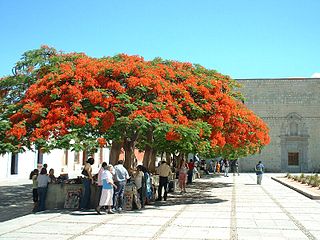
Caesalpinioideae is a botanical name at the rank of subfamily, placed in the large family Fabaceae or Leguminosae. Its name is formed from the generic name Caesalpinia. It is known also as the peacock flower subfamily. The Caesalpinioideae are mainly trees distributed in the moist tropics, but include such temperate species as the honeylocust and Kentucky coffeetree. It has the following clade-based definition:
The most inclusive crown clade containing Arcoa gonavensisUrb. and Mimosa pudicaL., but not Bobgunnia fistuloides(Harms) J. H. Kirkbr. & Wiersema, Duparquetia orchidaceaBaill., or Poeppigia proceraC.Presl
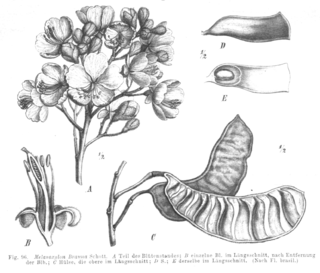
Melanoxylum is genus of plants in the legume family, Fabaceae. It includes a single species, Melanoxylum brauna, the yellow-flowered brauna tree. It is native to eastern Brazil. The genus is part of subfamily Caesalpinioideae.

Chrysobalanaceae is a family of flowering plants, consisting of trees and shrubs in 27 genera and about 700 species of pantropical distribution with a centre of diversity in the Amazon. Some of the species contain silica in their bodies for rigidity and so the mesophyll often has sclerenchymatous idioblasts. The widespread species Chrysobalanus icaco produces a plum-like fruit and the plant is commonly known as the coco plum.
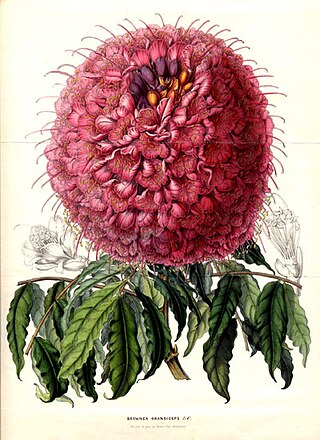
The subfamily Detarioideae is one of the subdivisions of the plant family Fabaceae (legumes). This subfamily includes many tropical trees, some of which are used for timber or have ecological importance. The subfamily consists of 84 genera, most of which are native to Africa and Asia. Pride of Burma and tamarind are two of the most notable species in Detarioideae. It has the following clade-based definition:
The most inclusive crown clade containing Goniorrhachis marginataTaub. and Aphanocalyx cynometroidesOliv., but not Cercis canadensisL., Duparquetia orchidaceaBaill., or Bobgunnia fistuloides(Harms) J. H. Kirkbr. & Wiersema.

Dialium is a genus of flowering plants in the family Fabaceae, subfamily Dialioideae. Velvet tamarind is a common name for several species. The genus includes 37 species which range from the tropical Americas to sub-Saharan Africa, Madagascar, India, Indochina, and western Malesia.

Stryphnodendron is a genus of flowering plant in the legume family, Fabaceae. It includes 28 species of trees and suffrutices native to the tropical Americas, ranging from Nicaragua to Bolivia, Paraguay, and southern Brazil. Typical habitats include tropical rain forest and riparian forest, seasonally dry forest, cerrado, and caatinga. It belongs to the mimosoid clade of the subfamily Caesalpinioideae.

Peltophorum is a genus of 5–15 species of flowering plants in the family Fabaceae, subfamily Caesalpinioideae. The genus is native to certain tropical regions across the world, including northern South America, central and southern Africa, Indochina, southeastern China, Malesia, New Guinea, and northern Australia. The species are medium-sized to large trees growing up to 15–25 m tall, rarely 50 m.
Diptychandra is a genus of flowering plants in the legume family, Fabaceae. It belongs to the subfamily Caesalpinioideae. It includes two species native to northern South America, ranging from Colombia to Bolivia, Paraguay, and southeastern Brazil.
Lophocarpinia aculeatifolia is a species of flowering plants in the legume family, Fabaceae. It is the sole species in genus Lophocarpinia. It is a tree native to Paraguay and northern Argentina. It belongs to tribe Caesalpinieae of subfamily Caesalpinioideae.

Recordoxylon is a genus of flowering plants in the legume family, Fabaceae. It includes three species of trees native to the tropical Amazon rainforest of northern South America, and the species' range includes northern Brazil, Colombia, French Guiana, Guyana, and Venezuela. Habitats include non-flooded rain forest on terra firme, seasonally-flooded riverine forest (várzea), and montane forest.
Stenodrepanum bergii is a species of flowering plants in the legume family, Fabaceae. It is a perennial subshrub native to northern Argentina. It is the sole member of genus Stenodrepanum. It belongs to tribe Caesalpinieae in subfamily Caesalpinioideae.

Dicorynia is a genus of flowering plants in the legume family, Fabaceae. It belongs to the subfamily Dialioideae. It includes two species of trees native to northern South America, ranging through Peru, Colombia, Venezuela, the Guianas, and northern Brazil.

Martiodendron is a genus of flowering plants in the family Fabaceae. It includes five species of trees native to northern South America, from southern Venezuela, the Guianas, and Peru to Bolivia and southeastern Brazil. Typical habitats include tropical rain forest, often periodically inundated, in both the Amazon and Atlantic forests, as well as seasonally-dry forest and wooded grassland (savanna), up to 600 meters elevation. The genus belongs to the subfamily Dialioideae.
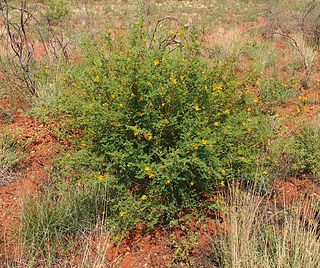
Petalostylis is a genus of flowering plants in the legume family Fabaceae. It is endemic to Australia, and includes two species of shrubs native to arid tropical areas of Queensland, New South Wales, South Australia, the Northern Territory, and Western Australia, where it grows on sand plains, stony ridges and rocky outcrops, creek beds, and scree slopes. It belongs to the subfamily Dialioideae.

Piliostigma is a genus of flowering plants in the legume family, Fabaceae. It includes five species of small deciduous trees native to sub-Saharan Africa, the Indian subcontinent, Indochina, Java, the Philippines, and northern Australia. It belongs to the subfamily Cercidoideae and the tribe Bauhinieae. It is dioecious, with male and female flowers on separate plants.
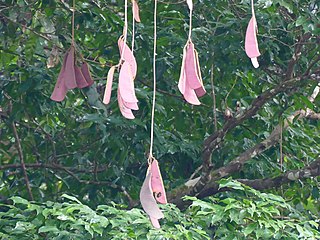
Eperua is a genus of flowering plants in the legume family, Fabaceae. It belongs to subfamily Detarioideae. It includes 16 species native to northern South America, in Colombia, Venezuela, the Guianas, and northern Brazil. They live in the jungles, often along rivers or streams. The leaves are compound pinnate, with smooth margins, and the fruits are long pods. The wood of E. falcata is called wallaba and is often used in construction.
Indopiptadenia is a genus of flowering plants in the family Fabaceae. It contains a single species, Indopiptadenia oudhensis, a tree native to the western and central Himalayas, including Nepal, and Uttar Pradesh in northern India. The genus belongs to the mimosoid clade in the subfamily Caesalpinioideae.
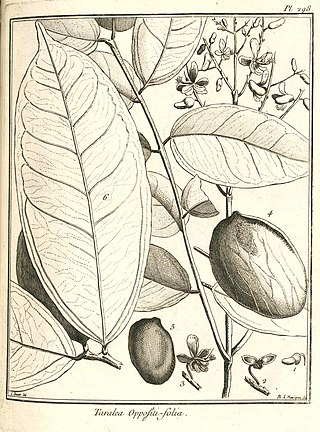
Taralea is a genus of flowering plants in the family Fabaceae. It includes five species of trees and shrubs native to northern South America, ranging from Colombia and Peru to Venezuela, the Guianas, and northern and northeastern Brazil. Habitats include riverine and inundated tropical lowland rain forest, seasonally dry forest, woodland, and marsh. One or two species are also found in montane forest and in open moist woodland and scrub on sandstone-derived soils. It belongs to subfamily Faboideae.

Vatairea is a genus of flowering plants in the legume family, Fabaceae. It includes eight species of tall trees native to the tropical Americas, ranging from southern Mexico to Bolivia and southern Brazil. Seven species are native to northern South America, with the center of diversity in Amazonia. Vatairea lundellii ranges from southern Mexico to Panama. Most species grow in tropical rain forest, often in the inudated forests known as igapó and varzea, where they are emergent trees, growing above the forest canopy. V. macrocarpa grows in seasonally-dry forest, cerrado, and caatinga.

Schnella is a genus of flowering plants in the legume family, Fabaceae. It belongs to the subfamily Cercidoideae. All of its species are neotropical lianas.














